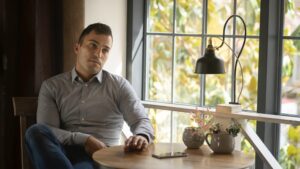Dr Boreham’s Crucible: How SomnoMed is placed in the $10.4 billion sleep apnoea market

Pic: Luis Alvarez / DigitalVision via Getty Images
As the head of a company selling mouthguard-like oral devices to combat obstructive sleep apnoea (OSA), Neil Verdal-Austin surprises us by praising the effectiveness of the standard-of-care rival pumps and masks sold by industry leaders ResMed and Respironics.
He says the continuous positive airways pressure (CPAP) units are 100 per cent effective — when worn that is.
The trouble is, the devices are renown for being uncomfortable and the compliance rate is extremely low at 30 to 50 per cent.
At the same time, most OSA sufferers are recommended CPAP devices, even though oral devices could be suitable for two-thirds of users (patients with mild to moderate snoring).
“It’s like prescribing someone a wheelchair before crutches and that doesn’t make sense to me,” SomnoMed’s (ASX:SOM) Verdal-Austin says.
SomnoMed markets continuous open airway therapy, or COAT.
SomnoMed’s SomnoDent mouthguard is a mandibular advancement splint that moves the lower jaw slightly forward, keeping the airway open at all times.
The company sells in 28 countries and has treated 500,000 patients, including a failed CPAP cohort and previously untreated users.
Based on “patient feedback”, SomnoMed claims that 91 per cent of users have a better night’s sleep, with 88 per cent using the device regularly.
What’s more, all of the patients continued using the device to treat their condition over the longer term.
SomnoMed listed in August 2004, raising $12m at 30c apiece.
The company initially was based on a device called the SomnoMed MAS (mandibular advancement splint), invented by Sydney retired consultant orthodontist and champion rower Dr Richard Palmisano, who died in 2009.
US strategy put to sleep
Despite its steady growth, Somnomed has undergone several strategy pivots, notably a hasty and costly retreat from its headline strategy of setting up a chain of direct-to-patient US sleep diagnostic centres, Renew Sleep Centres (RSS).
“We have been through different strategic and board changes as we work out what we are, and who we are best at treating,” Verdal-Austin says.
SomnoMed opened its first RSS centre in December 2016 but abandoned the strategy in December 2018, having opened four of the intended 16 outlets.
The core problem, in short, was a change to health insurance policies that increased patients out of pocket expenses (sound familiar?) and reduced reimbursement rates for SomnoMed.
While the chain received 60,000 inquiries, patient conversions were not strong enough.
“Whilst we believe there may be a future for a direct-to-patient approach in the US … it would require more time, more money and a lot of good management to turn RSS into the business we were originally expected to have,” chairman Peter Neustadt said at the time.
The RSS fiasco saw the departure of US-based CEO Derek Smith, who was replaced by Verdal-Austin, the company’s long time CFO and chief operating officer.
In those roles, Verdal-Austin was integral to all of the company’s major decisions, including establishing a manufacturing facility in the Philippines and — presumably — the RSS strategy.
“We went a little bit too quickly,” he says of the US misstep.
“The RSS concept was borne out of the fact that the process of sleep specialists referring sleep-study patients to dentists was really slow.”
SomnoDent Avant
While SomnoDent continues to sell okay, no device company can stand still and SomnoMed is working on its next iteration: the digitally manufactured SomnoDent Avant.
Avant avails of computerised design and manufacturing techniques to produce the mouthguards cheaper and more quickly.
It’s also promised to be more comfortable for the user — a key driver of compliance — and highly durable.
Avant will enable dentists to form mouth impressions with intra-oral scanners, rather than gunk.
“We can manufacture our device in our Philippines facility within minutes,” Verdal-Austin says.
“It’s a new manufacturing process for us. While others have done this, I believe we have done this right.”
SomnoMed also tackles the nocturnal blight of bruxism — teeth grinding that can wear down the pearly whites. Bruxism can also be an indicator of OSA.
A cheaper COAT is sometimes better.
As always with medical devices, cost is a key factor in the CPAP versus COAT equation.
The Avants sell for around $500, or the equivalent 500 units in other major currencies (unfortunately for snorers in Indonesia, they don’t sell for 500 rupiahs, or about 5c).
Because the devices have to be fitted by a dentist — that fiddles around with the mandible — the total cost comes in at $1,500 to $2,000.
CPAP treatments cost in the thousands, but in some countries the devices can be rented.
Putting the bite on dentists
In theory, SomnoMed’s target market should be the dentists, given they’re the ones fitting the devices.
But typically snorers won’t go to a dentist with an OSA problem: they’ll go to a general practitioner and be referred to a sleep specialist, with the dentists then getting the mandate to fit the devices (by law, only dentists are allowed to).
Having said that, Verdal-Austin describes dentists as “partners” of the company, which seeks alignment with the large dental groups.
Over the last four years SomnoMed has built a network of 20,000 to 25,000 dentists.
“Whether you have one dentist or a roll-up, our job is the same: train and educate them to treat obstructive sleep apnoea effectively with an oral appliance,” Verdal-Austin says.
Of the 28 countries in which SomnoMed currently sells, the company distributes directly in 27 (the exception being a Singapore-based third party deal).
Surveying the competitive landscape
Verdal-Austin estimates that oral devices account for about 10 per cent of the sleep apnoea market, but it’s not as if the company has the market to itself.
“Over the last 10 years we have attracted more and more competitors as we have gone along,” he says.
Rivals tend to operate in only certain regions: in the US, it competes with Prosomnus Sleep Technologies and TAP (as in Thornton Adjustable Positioner).
“We’re competitors on one side, but also industry leaders trying to grow the size of the prize,” Verdal-Austin says.
ResMed also has an oral device called Narva, a business acquired seven years ago: “but they haven’t done much with it”.
Then there’s Oventus, which listed on the ASX in 2015.
Founded by entrepreneurial dentist Dr Chris Hart with some heavy-hitting backing, Oventus sells mouthguard devices called O2Vents, with a pipe forcing air to the back of the throat.
Finances and performance
SomnoMed this week reported a net loss of $15.76m for the year to June 30 2019, compared with a $6.93m deficit previously.
Earnings before interest, tax, depreciation and amortization fell 13 per cent to $3.39m.
Revenue climbed 12 per cent to $58.89m.
Management also reports core earnings before interest, taxation, depreciation and amortisation (EBITDA) of $4.94m, up 27 per cent (this number excludes some inconvenient one-off expenses, such as the former CEO’s severance payment).
The reported loss mainly was the result of $16.39m of expenses and write downs pertaining to the RSS closure.
“As far as I can legally say, we have provided all the future costs [of the closure] we could possibly experience,” Verdal-Austin says.
SomnoMed ended the year with cash of $7.69m. On the debt side, the company has an overdraft facility of $5m — $3m of which has been drawn down.
Verdal-Austin says the company has recovered 95 per cent of the US clients that were lost during the RSS closure, with a turnaround evident in the fourth (June) quarter.
He is especially chuffed that direct dentist revenue in North America improved by 31 per cent.
Management has guided to revenue of $67m to $69m for the current year, up 14 to 17 per cent.
EBITDA — the reported version rather than the core one — is expected to climb by 26 per cent to 34 per cent, to $6.3m to $6.7m.
“We are very excited about the turnaround we are going to have in the business,” Verdal-Austin says.
Investors weren’t so convinced, knocking 15c, or 7.5 per cent off the share price on the day. Two days later, they changed their mind and added 25c, or 13 per cent to the valuation.
The gyrations continue the topsy-turvy ride of SomonMed shares, which slumped to a record low of $1.45 in late June and then climbed to a 12-month peak of $2.34 in late July.
The shares hit an all-time zenith of $4 in October 2016.
Dr Boreham’s diagnosis:
Given that roughly four-fifths of obstructive sleep apnoea cases are undiagnosed and thus untreated, SomnoMed has plenty of room to grow.
The company estimates the global sleep apnoea market at $US7 billion ($10.4 billion) to $US8 billion, growing at six to eight per cent a year.
In the key markets where SomnoMed operates, the share of COAT treatments as a proportion of the total OSA market ranges from four per cent (Italy) to 52 per cent (Sweden).
In Australia, 15 per cent of mild snorers treated use mouthguard devices.
Sleep Health Foundation Australia claims that more than 1.5 million Australians have a sleep disorders, more than half for obstructive sleep apnoea.
Verdal-Austin estimates 2.5 million new CPAP machines are sold in the US each year, which implies plenty of disaffected users that can be wooed over to the SomnoDents.
As always, SomnoMed’s success will come down to the cost and efficacy of the devices and the availability of reimbursement.
The use of artificial intelligence also means the company will be able to share accrued patient data with physicians and dentists, thus allowing them to predict suitable COAT candidates.
SomnoMed looks to be on the right track, despite the somewhat blah full-year numbers.
Management’s work has only just begun. “We have a long way to go to persuade sleep experts to try COAT,” Verdal-Austin says.
Disclosure: Dr Boreham is not a qualified medical practitioner, does not possess a doctorate of any sort and does not snore – in his waking hours at least.
This column first appeared in Biotech Daily.
The content of this article was not selected, modified or otherwise controlled by Stockhead. Stockhead has not provided, endorsed or otherwise assumed responsibility for any financial product advice contained in this article.
UNLOCK INSIGHTS
Discover the untold stories of emerging ASX stocks.
Daily news and expert analysis, it's free to subscribe.
By proceeding, you confirm you understand that we handle personal information in accordance with our Privacy Policy.








